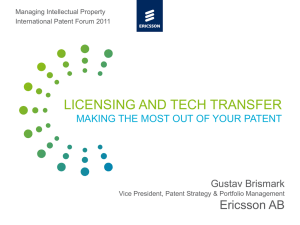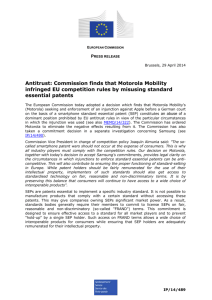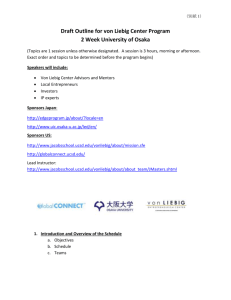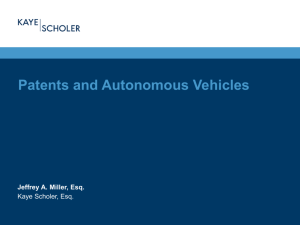patent roundtable
advertisement
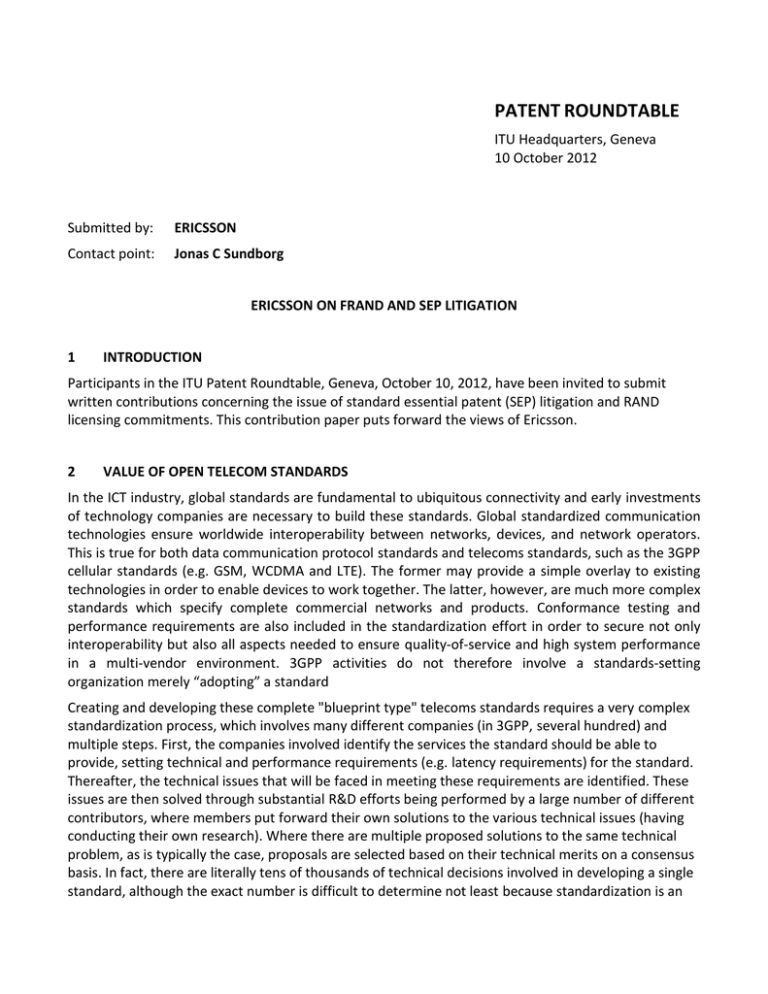
PATENT ROUNDTABLE ITU Headquarters, Geneva 10 October 2012 Submitted by: ERICSSON Contact point: Jonas C Sundborg ERICSSON ON FRAND AND SEP LITIGATION 1 INTRODUCTION Participants in the ITU Patent Roundtable, Geneva, October 10, 2012, have been invited to submit written contributions concerning the issue of standard essential patent (SEP) litigation and RAND licensing commitments. This contribution paper puts forward the views of Ericsson. 2 VALUE OF OPEN TELECOM STANDARDS In the ICT industry, global standards are fundamental to ubiquitous connectivity and early investments of technology companies are necessary to build these standards. Global standardized communication technologies ensure worldwide interoperability between networks, devices, and network operators. This is true for both data communication protocol standards and telecoms standards, such as the 3GPP cellular standards (e.g. GSM, WCDMA and LTE). The former may provide a simple overlay to existing technologies in order to enable devices to work together. The latter, however, are much more complex standards which specify complete commercial networks and products. Conformance testing and performance requirements are also included in the standardization effort in order to secure not only interoperability but also all aspects needed to ensure quality-of-service and high system performance in a multi-vendor environment. 3GPP activities do not therefore involve a standards-setting organization merely “adopting” a standard Creating and developing these complete "blueprint type" telecoms standards requires a very complex standardization process, which involves many different companies (in 3GPP, several hundred) and multiple steps. First, the companies involved identify the services the standard should be able to provide, setting technical and performance requirements (e.g. latency requirements) for the standard. Thereafter, the technical issues that will be faced in meeting these requirements are identified. These issues are then solved through substantial R&D efforts being performed by a large number of different contributors, where members put forward their own solutions to the various technical issues (having conducting their own research). Where there are multiple proposed solutions to the same technical problem, as is typically the case, proposals are selected based on their technical merits on a consensus basis. In fact, there are literally tens of thousands of technical decisions involved in developing a single standard, although the exact number is difficult to determine not least because standardization is an -2- ongoing process.1 Importantly, this is a risky investment of precious R&D resources; the expenditures must occur years before any products are actually manufactured or sold, and without any guarantee that the solutions will be incorporated into the standard. In the end, this process results in a state-ofthe-art complete system specification in which only the superior technical solutions make it all the way into the standard, thus maximizing the benefit for consumers. The benefits of this process are many, from enabling multi-vendor operability and economies of scale via lower implementation costs (with all solutions meeting industry requirements from the start) to the fact that an open development process ensures specifications are well-engineered and based on cutting-edge technology. These SEP holders have thereby together created a complete and ready platform for a wide range of businesses of the entire value chain in Europe and beyond, enabling employment and economy growth. Looking towards the future, it is commonly agreed that continuous long-term investment in R&D and communication system standards is required in order to meet the objectives of the Digital Agenda for Europe and the ever increasing demand for mobile data usage (targeting 5 billion mobile broadband subscriptions by 2016). Protecting patent rights for individual contributions to such technology development (and the necessary means to enforce them) is a prerequisite for the underlying business case of innovators to continue to invest in open standards for the future. 3 FRAND LICENSING: WELL BALANCED APPROACH Many different groups of companies, each with different interests, are typically involved in the standard-setting process. There are, for example, upstream-only companies (which solely develop and market technologies), downstream-only companies (which solely manufacture products or offer services based on technologies developed by others and do not hold relevant IPR), vertically integrated companies (which both develop technology and sell products that incorporate this technology), and companies which are solely industrial buyers of standardized products (which neither manufacture those products nor develop technologies for inclusion in the standard).2 Even if there is a natural tension among these different companies’ interests in the standard-setting process due to their different business models and strategies, these companies nevertheless essentially have the same goal, i.e. to provide end-users with advanced capabilities at reasonable market prices, in order to make the telecoms sector as successful as possible. Technology sharing within the telecoms sector is ensured by way of commitments by patent holders to restrict some of their normal patent rights and instead to license their SEPs on FRAND terms. One of the major purposes of the FRAND commitment is to ensure that the adoption of the standard in question cannot be blocked, i.e. FRAND obligations are meant to ensure that the standard can be implemented. This fair return licensing system provides incentives for innovators to contribute their investments in R&D to the standard. In addition, since the commitment to license on FRAND terms applies wider than to just members of the relevant standard body, anyone that wishes to implement a ____________________ 1 For example, the first GSM standard specifications were published in 1990, but further standardization is still ongoing today as the standard evolves. 2 This is also acknowledged by the European Commission in its Horizontal Guidelines, Standardization Chapter, see http://eur-lex.europa.eu/LexUriServ/LexUriServ.do?uri=OJ:C:2011:011:0001:0072:EN:PDF -3- standard can rely on innovators’ FRAND commitments for access at reasonable costs. This means that the market is accessible to new players to launch competitive and successful products without any investment in developing the standards in question. In fact, in the past decades, a large number of such new vendors have emerged around the world and become highly successful, demonstrating that the principles of open access to standards and sharing of IPR through FRAND licensing do serve as true market enablers. Indeed, the European telecoms industry has enjoyed remarkable growth in the last two decades, providing affordable communication to billions of people worldwide. Prices of devices and network services have fallen. In addition, devices and network equipment are empowered by continuously improved and standardized technologies, generating enhanced performance and superior features for consumers, such as mobile broadband Internet access, music and video streaming, social networking, location-based services and online gaming. FRAND licensing is a critical element of future standards development. The need for any reform of the FRAND system must therefore be carefully considered. 4 MAINTAINING THE FRAND BALANCE Some industry participants (as well as academics and government officials) have recently suggested that SEP holders should be prohibited from seeking injunctive relief against implementers that manufacture products that infringe a SEP holder’s patent by implementing such standards without paying FRAND royalties for their use. A number of proposals have also been made to pre-determine a royalty base common to multiple standards, and various principles for calculating royalty levels. Ericsson believes that many of these proposals must be rejected to maintain the FRAND balance and encourage future contributions to open standards. 4.1 INJUNCTIONS The right of a patent holder to seek and, under appropriate circumstances, obtain injunctive relief is one of the basic rights of patent holders to prevent others from using their patented inventions. SEPs should be no exception to this universal rule. In situations where SEP holders have exhausted reasonable efforts in offering and negotiating a license on FRAND terms, it must be legitimate for them to seek, and under certain circumstances obtain, an injunction against a potential licensee that is unwilling to negotiate in good faith on FRAND terms and in a timely fashion. Importantly, the European Commission shares this view: Furthermore, the seeking or enforcement of injunctions on the basis of [standard essential patents] is also not, of itself, anti-competitive. In particular, and depending on the circumstances, it may be legitimate for the holder of [standard-essential patents] to seek an injunction against a potential licensee which is not willing to negotiate in good faith on FRAND terms.3 ____________________ 3 Case No. COMP/M.6381 – Google/Motorola Mobility, Commission decision pursuant to Article 6(1)(b) of Council Regulation No 139/2004, February 13, 2012, available at: http://ec.europa.eu/competition/mergers/cases/decisions/m6381_20120213_20310_2277480_EN.pdf -4- Allowing SEP holders to seek injunctive relief remains the most prudent course of action to encourage parties to reach negotiated agreements on the terms and conditions of licensing arrangements on global portfolios of essential patents. Otherwise, SEP-holders will be undercompensated for their R&D contributions and lose their incentive to contribute to open standards in the future as explained below. Absent injunctive relief (or by imposing too restrictive conditions on its availability to SEP holders), a technology developer would only be left with court-awarded national damages as a remedy for infringement of its SEPs. Court-ordered damages cannot, however, fully compensate SEP holders. First, it is important to remember that the telecoms sector is characterized by significant investments in R&D that result in large portfolios of patents and, since it is a global market, these portfolios are typically spread throughout many different countries. This, in turn, means that implementers need global portfolio-wide licenses. However, one national court cannot decide on the global value of entire patent portfolios (containing, for example, hundreds of different patent families). Most courts already take one year or more to decide infringement claims relating to a single or just a few national patents. In addition, no court is willing or able to award damages beyond the borders of its jurisdiction. Second, in many developing countries, injunctions are the primary remedy for patent infringement where national legal systems do not provide for full compensatory damages. Litigating for damages only, on a country-by-country and patent-by-patent basis, would therefore impose high litigation costs on SEP holders and result in sub-FRAND rates as licensing royalties will be determined by the transaction costs of litigation rather than the fair and reasonable value of the technology contributed to the standard. Today, there are literally tens of thousands of standards approved as national or international standards. It is true that there have been and continues to be ongoing patent infringement proceedings between various companies in the telecoms sector, as well as complaints to competition authorities concerning the enforcement of SEPs. It is, however, important to recognize that those patent infringement proceedings and antitrust complaints are natural elements of a well-functioning and highly competitive market, in which the majority of negotiations between market players actually result in mutually beneficial SEP license agreements on FRAND terms. At the same time, it also bears emphasis that the vast majority of ongoing litigation relates to non-SEPs, where the patent holder in question has no commitment to even offer a license. Some of these cases involve patent holders who are seeking injunctive relief for non-SEPs while at the same time advocating against the right to an injunction for SEPs in any circumstances. In fact, national courts are well-equipped to strike the right balance between the parties’ different interest while appropriately considering public interests. There are a number of recent decisions from the US, UK, Dutch and German national courts where judges have refused to allow injunctions where licensing offers were deemed not to be FRAND, or there was an absence of good faith negotiation.4 Restricting the availability of injunctive relief to SEP holders would create an imbalance by discriminating against those who have invested in standards in favor of those who have chosen to invest in proprietary technology. This would undermine the incentives for technology developers to ____________________ 4 For example; Nokia Oyj v. IPCom GmbH, judgment of 18 May 2012, [2012] EWHC 1446 (Ch), at 2, and Apple Inc. et al. v. Motorola, Inc., et al., Civ. A. No. 11-08540, Docket No. 1038 (22 June 2012). In addition there is also an extensive body of German case law which permits SEP holders to seek injunctive relief where a licensee refuses to agree to an offer of a license made on FRAND terms. (see, for example, Motorola v. Apple, Mannheim District Court, Judgment of 9 December 2011, 7 O 122/11; and Motorola v. Microsoft, Mannheim District Court, Judgment of 2 May 2012, 2 O 240/11) -5- make future investments for continued development of these standards. The fact that prohibiting injunctive relief for SEP holders would lead to complicated negotiations and reduce patent value, which in turn would harm innovation is recognized in Hill Wellford and Bingham McCutchen’s article “Reasons to Reject a “No Injunctions” Rules for SEPs and FRAND-Obligated Patents”5: “..Under normal FRAND practice, the innovator and the infringer/licensee both have strong incentives to negotiate: the infringer does not wish to risk an injunction that could prevent or disrupt its manufacturing, and the innovator does not wish to appear unreasonable or to subject its entire licensing system to a court judgment. In addition, the innovator would get not royalties from the infringer during any period in which an injunction is in force. Such matching incentives encourage negotiation, which is a good thing. It has long been recognized that, as a method of solving commercial disputes, negotiations are cheaper faster less error-prone and otherwise more efficient than litigation. But if injunctions were barred, the infringer would have a reduced incentive to bargain. One result would be more and longer litigation with all the inefficiency that litigation entails. …[I]f injunctions were prohibited for a class of patents, value for that class of patents would be destroyed. ” 4.2 ROYALTY BASE AND ROYALTY RATE It is Ericsson’s position that patent holders need to consider their contribution to a particular standard, in relation to other contributions, when setting their FRAND royalty, and that a FRAND offer needs to be substantiated by argument in bilateral negotiation, where the licensee is also allowed to challenge such substantiation. It is also Ericsson’s position that market forces will drive aggregated royalties to a reasonable level. In contrast, it is not appropriate for SSOs or competition authorities to prescribe specific principles governing commercial terms, such as royalties. Such commercial issues should be left to commercial negotiations outside the SSOs. Ericsson supports Nokia’s view that: “It should be left to market participants to implement royalty terms that are the most efficient to agree and administer, rather than SSOs imposing particular solutions or limitations.”6 Some industry participants have proposed changes to the current FRAND policy aimed at legislating the royalty base and royalty rate to be applied in licensing negotiations, rather than allowing the parties to freely negotiate a license agreement. Like the suggestions to prohibit injunctions on SEPs, these proposals have the potential to upset the FRAND balance. First, the price of a baseband chipset has been suggested as the appropriate royalty base for patents essential to ETSI cellular standards. This in not a fair approximation of value of these standardized technologies, because chipset costs do not account for investment in making the standard; they merely reflect the cost of making a piece of hardware without R&D other than in regards to the chipset manufacturing. Few people would dispute that the price of a DVD film should allow for the investment in the full production of the film, not only the manufacturing costs of storing it on the disc. Likewise, most people would recognize the legitimacy of charging more for a CD containing useful software than the mere ____________________ 5 CPI Antitrust Chronicle, April 2012 (2). Available at: http://www.bingham.com/Publications/Files/2012/04/No-InjunctionsRule 6 Nokia contribution to ITU titled: ”SEP litigation and [F]RAND licensing commitments” Geneva October 10, 2012. Ericsson supports the views expressed in this contribution -6- manufacturing costs for storing that software on the CD. Consequently, there is little merit to the argument that the value of 3GPP/ETSI standardized technologies could be reflected by the manufacturing costs of the chipset. Second, it has also been suggested that an industry average sales price for a basic communication device, capable of voice and data transmission could be an appropriate royalty base for patents essential to ETSI cellular standards. This proposal fails to recognize the huge difference in value between GPRS (SMS, MMS), WCMDA/HSPA (mobile email) and LTE Advanced (mobile broadband) respective data capacity. The increased performance of these standards has enabled new services such as video streaming, requiring high data speed and increased quality of service, and on-line gaming, requiring high data speed and lower latency. It is clear that a higher value can be enjoyed from the standard with increased performance, and that the customer demand will be higher for an end-user product with higher capacity. Moreover, it is impossible to prescribe rules that will apply to all current and future products sold compliant with a standard. The same royalty rules cannot apply to phones, smart meters, cars, base stations, laptop computers, and any unknown future products. What has to be assessed is what the standardized technology contributes to the customer demand for the product in question. Royalty rates based on just the chipset price or an industry average sales price of some basic communication device would fail to adequately capture the added value of the standardized technology, which ought to properly reflect the R&D that SEP holders have invested in developing the standard. Third, other proposals suggest that the value of essential patents should be calculated as the value of the technology if it had not been standardized. This position fails to take into account that telecommunication, or communication for that matter, is completely reliant on standardization. The interoperability achieved through standardization is inseparable from the technology itself. GSM – without the GSM standard – is not GSM. Moreover, the fact that an invention has been chosen for inclusion in the standard is a strong indicator of the value of the invention. As discussed above, a standard includes only the best solutions adopted after the evaluation, competition, and testing of the standard-setting process. Fourth, proposals have been made to use incremental contribution as a measure of value for the patented technology. This approach is flawed because it fails to consider that next best alternative is most likely protected by a patent also. This approach is also infeasible, especially for large patent holders like Ericsson. Requiring a company that holds hundreds of SEPs on a global basis to incrementally quantify the value of each patent would be a waste of resources, and would not aid in the negotiation of a FRAND license. 5 CONCLUSIONS The current FRAND licensing framework, with the possibility of using injunctive relief to protect a SEP holder’s rights, has created wider choices for consumers and helped to reduce prices and improve product quality in the telecoms sector. It is important not to tilt the balance in this well-functioning ecosystem with broad regulatory intervention, either by SSOs or competition authorities. In particular, most of the current suggested changes to the availability of injunctive relief for SEPs or the calculation of royalties lean too heavily towards the interests of downstream implementers. It is -7- worth noting that the companies that seek these changes are often primarily downstream implementers that develop and deploy advanced products and services based on these “blueprint type” technical standards. Although these companies benefit from technical advancements provided by the standards in terms of increased performance and capabilities of the downstream products and services they deliver and the opportunity to enter quickly the telecoms market, they now seek to change the same FRAND system that enabled their market entry. It is Ericsson’s view that incentives to engage in risky and costly R&D of complex technologies, and to contribute those technologies to standards, must be maintained. Thus, intervention should be directed towards specific cases of flagrant patent abuse. Since national court systems are already well-equipped to strike the right balance in patent disputes, while at the same time encouraging the partied to reach a market-negotiated agreement, no further modification or reform of the system is necessary. Notes: Ericsson is the world's leading provider of communications technology and services. We are enabling the Networked Society with efficient real‐time solutions that allow us all to study, work and live our lives more freely, in sustainable societies around the world. We operate in 180 countries and employ more than 100,000 people. Founded in 1876, Ericsson is headquartered in Stockholm, Sweden. In 2011 the company's net sales were SEK 226.9 billion (USD 35.0 billion). Ericsson is listed on NASDAQ OMX, Stockholm and NASDAQ, New York stock exchanges. Our offering comprises services, software and infrastructure within Information and Communications Technology for telecom operators and other industries. Today more than 40 percent of the world's mobile traffic goes through Ericsson networks and we support customers' networks servicing more than 2.5 billion subscribers. In addition, Ericsson is uniquely positioned as a leader in the development of standards for all major mobile and fixed communication systems and the convergence of these systems. Ericsson employs around 22,000 people who are devoted to its R&D efforts and in 2011, increased its investment in R&D to €3.5 billion (14.4% of total net sales) to further strengthen its technology leadership. Ericsson focuses on early involvement in creating new technologies, strong contributions to standardization work and development of IPR. As a result, Ericsson pioneered the development of digital AXE switching and has been a major driver behind and contributor to the development of the global standards for GSM, WCDMA and LTE for over 25 years, investing billions of Euros, resulting in 30,000 granted patents. This means that Ericsson holds the world’s strongest SEP portfolio for telecommunications. ___________
